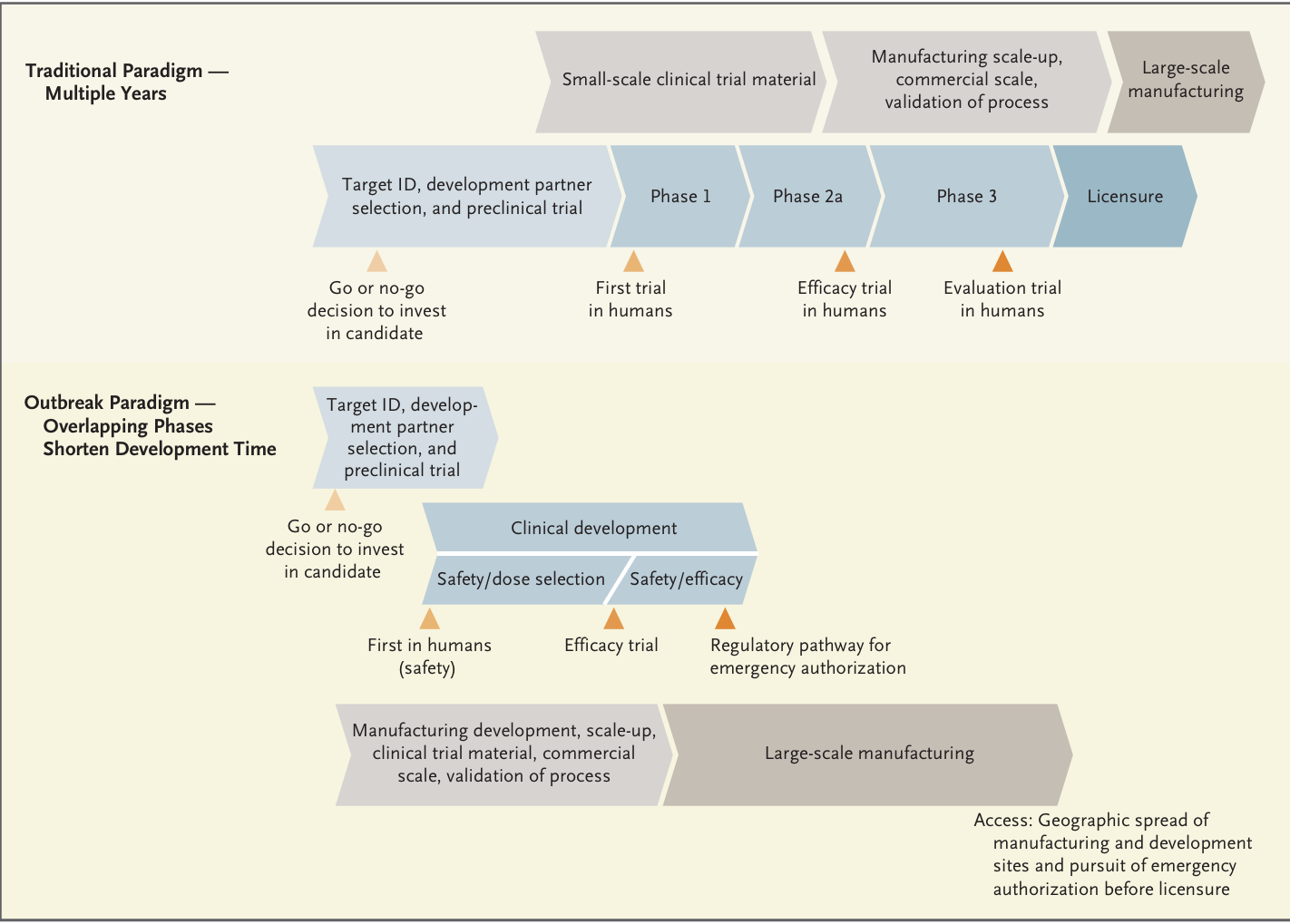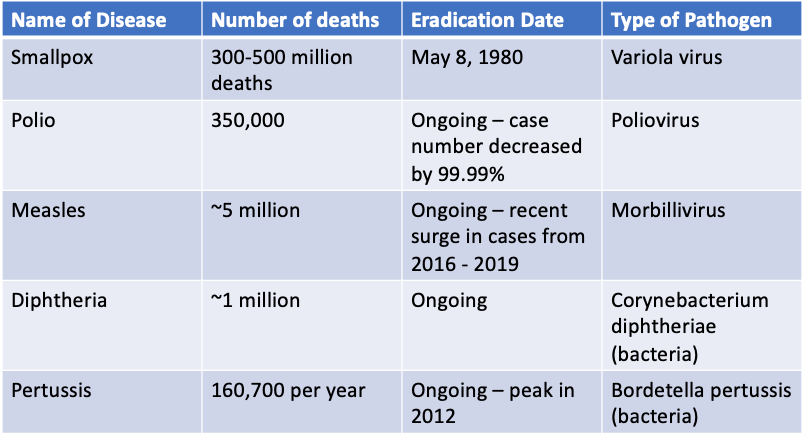by Buck Institute
March 18, 2021 . BLOG
The 8th Wonder of the World: Saving Lives
Here is part 2 of the first blog in a series from Dominican University Master’s students. In today’s post, the team dives into the specifics of the COVID-19 vaccine with information that will make it clear that the vaccine is safe and will save hundreds of thousands of lives. You can read part 1 here.
Authors: Anne Marker, Melia Granath-Panelo, Natalie Hill, Cavan Patterson;
Edited by Dr. Pankaj Kapahi, Buck Professor

How is the United States handling COVID-19 vaccinations?
According to the New York Times, the rollout of the COVID-19 vaccine in the United States is slow, though it is rapidly ramping up. Below is a table outlining problems with vaccine rollout in the United States and how they can possibly be solved.
|
Problem |
Solution |
|
This has never been done before |
Notes can be taken from past pandemics so that state and federal governments can work together to carefully plan the logistics of the vaccine for the public as well as continue to educate the public with reliable resources. |
|
Vaccine supply is limited and uncertain |
As time goes on, production of the approved vaccine is increasing. Additionally, new vaccines are coming onto the market, meaning that there will be an even greater supply of vaccines soon. |
|
States are left largely to their own devices |
The federal government needs to take on a larger role in directing state governments on how they should proceed during vaccine distribution. This coordination will help empower the states to better plan vaccine allocation. |
|
Public health departments are underfunded |
Resource allocation during this public health emergency would create funds to allow for better vaccine distribution and a well thought out education program addressing questions about the vaccine |
|
Hospitals are overwhelmed with COVID patients and are unavailable to perform vaccinations |
This problem is being worked on as large-scale vaccination clinics are being set up by the government so hospitals can focus on patients who have COVID-19. |
|
Not everyone wants the shot |
Education campaigns need to be funded now more than ever so that the public will feel comfortable receiving the vaccine whenever it is their turn. |
|
States set aside doses for high-priority groups |
As the government has tried to prioritize certain groups for vaccines ahead of others, this process has resulted in some vaccines going unused therefore, states could implement a waiting list of people who could be contacted if vaccines become available. |
* https://www.aarp.org/health/conditions-treatments/info-2021/slow-covid-vaccine-rollout.html
After seeing the problems associated with the proper distribution of the COVID-19 vaccine, it is understandable why the United States has faced challenges in quickly bringing the vaccine to its people. If we continue with our rate of vaccinations in the country currently, it is projected that we may reach herd immunity (70-90% of the population vaccinated) by late summer or the end of this year.
MythBusters: The Facts About the COVID-19 Vaccine
At the end of the day, advancements in science only go so far as the public allows for them. Unlike vaccines created years and even decades ago, the COVID-19 vaccine has caused a flurry of media attention and coverage, proving the phrase “no publicity is bad publicity” to not always be true. For some, this vaccine has been the light at the end of a long and dark tunnel; for others, it merely adds to the growing number of ‘unknowns’ associated with this virus. As we address some of the concerns and grey areas surrounding the vaccine, let’s try to keep in mind conspiracy from truth, myth from fact, and ‘clickbait’ from real journalism. Mistrust in vaccines dates back centuries ago, to the creation of the very first vaccine by Dr. Jenner. However, in the spirit of evolution, it would be a shame for such a chasm to exist between science and society during the most exciting time for medical sciences throughout all of history.
 To bridge that gap, let’s address some of the rumors surrounding this vaccine. The first being, “the vaccine was developed too quickly.” In reality, the absolutely unprecedented world-wide collaboration between scientists and the immediate decision to fund this research is what was able to speed up the development process. Normal vaccine trials take multiple years and up to a decade, because of steps like participant recruitment, approvals and authorizations, and the ramping-up of large-scale manufacturing. With the COVID-19 vaccine, each clinical trial stage, approvals, and large-scale manufacturing was done at the same time thanks to the heightened sense of urgency. No essential steps were skipped as detailed in Figure 6, which marks an amazing benchmark for science!
To bridge that gap, let’s address some of the rumors surrounding this vaccine. The first being, “the vaccine was developed too quickly.” In reality, the absolutely unprecedented world-wide collaboration between scientists and the immediate decision to fund this research is what was able to speed up the development process. Normal vaccine trials take multiple years and up to a decade, because of steps like participant recruitment, approvals and authorizations, and the ramping-up of large-scale manufacturing. With the COVID-19 vaccine, each clinical trial stage, approvals, and large-scale manufacturing was done at the same time thanks to the heightened sense of urgency. No essential steps were skipped as detailed in Figure 6, which marks an amazing benchmark for science!
The next and probably largest concern is that the vaccine could have ingredients in it that are potentially harmful. While some of the names are long and confusing, none of them are harmful for you in any way, and you probably have already come in contact with most if not all of them at some point in your life! The vaccine is broken down into four main classes of ingredients, the mRNA, fats which encapsulate the mRNA, salts, and sugar. One of the fats has a chemical name of 1,2-Distearoyl-sn-glycero-3-phosphocholine (DSPC). Long and complicated, right? This name serves to identify different regions within the structure of the lipid, but the molecule itself is already found in our bodies and in many animal fats that we consume every day.
The next class of ingredients is salts, one of which is called monobasic potassium phosphate. This salt is a common source of electrolytes, which are essential for your hydration, and it helps regulate the pH of the vaccine. Since it is such a good source of electrolytes, it is used as a common ingredient in Gatorade and other popular sports drinks, which are safe to consume for people of all ages. Pretty harmless, right?
The ingredient getting the most publicity lately has been polyethylene glycol (PEG). In the vaccine, PEG serves to help the fats that surround the mRNA molecules stay together in one cohesive package. This may not sound like something that is safe to put in our bodies, but we probably already have in some way without even knowing it! This is because PEG is used in many products that we use every day, like skin cream and toothpaste. However, even though a chance of allergic reaction is extremely small, it is being advised that you wait 15 minutes after receiving each dose of the vaccine to ensure your health and safety.
Ghosts of pandemics past
In the modern era, nearly 225 years after the invention of the vaccine, we live in a general placated state against the dangers that were once so real for many people across the globe. We are beginning to slip back into an era of avoiding vaccinations. For argument sake, let's look at some figures that put things into perspective. Approximately 300 million childhood illnesses were prevented, and more than 700,000 premature deaths were avoided between 1994 and 2013 due to regular vaccination against diseases like polio, MMR, chicken pox and DTaP. 300 million is roughly equivalent to the current population of the United States reported by the 2019 census (actually 328 million). Looking at this data, it is hard to argue that routine vaccination is to the detriment of society.

Examples of common childhood diseases that are commonly vaccinated against. Note that both bacteria and viruses can be vaccinated against. Due to the recent anti-vax movement, many of these diseases are making inroads in the community again.
For most current Americans, worries of catching these diseases has become so far removed that the importance of routine vaccination is often overlooked. Because of this lack of fear, and the easy spread of misinformation, it is becoming increasingly common for parents to pass up the opportunity to vaccinate their children. Vaccine coverage is falling, and diseases once thought beaten are making new inroads. The incidence of pertussis has increased in the United States in the last 20 years, with 28,660 cases reported in 2014. In 2014, 644 cases of measles were reported in the U.S., the highest in any year since 1996. Those who forget the past are prone to make the same mistake in the future. Therefore, we must remain thankful for the invention of vaccines and continue to make them common practice in the public sector.
COVID-19 Resources
In order to find out when it is your turn to get vaccinated for the COVID-19 pandemic we are currently facing, you can refer to recommendations from the Centers for Disease Control and Prevention (CDC) on this website for specific information about when you will be able to receive your vaccine and how you will be able to schedule one. As it may seem daunting trying to find information online, looking directly at sources from federal public health institutes like the CDC will allow you to find accurate and up-to-date information.
Bibliography
CDC. History of Vaccine Information Statements. www.cdc.gov/vaccines/hcp/vis/downloads/vis-history.pdf.
Crum, Frederick S. “A STATISTICAL STUDY OF DIPHTHERIA.” American Journal of Public Health, vol. 7, no. 5, 1917, pp. 445–477., doi:10.2105/ajph.7.5.445-a.
Feemster, Kristen A. “A Brief History of Vaccines.” Vaccines, 2017, doi:10.1093/wentk/9780190277901.003.0002.
Jop de VriezeDec. 21, 2020, et al. “Suspicions Grow That Nanoparticles in Pfizer's COVID-19 Vaccine Trigger Rare Allergic Reactions.” Science, 13 Jan. 2021, www.sciencemag.org/news/2020/12/suspicions-grow-nanoparticles-pfizer-s-covid-19-vaccine-trigger-rare-allergic-reactions.
Juul, Frederik E, et al. “Mortality in Norway and Sweden before and after the Covid-19 Outbreak: a Cohort Study.” MedRxiv, Cold Spring Harbor Laboratory Press, 1 Jan. 2020, www.medrxiv.org/content/10.1101/2020.11.11.20229708v1.
Lahariya, Chandrakant. “Vaccine Epidemiology: A Review.” Journal of Family Medicine and Primary Care, Medknow Publications & Media Pvt Ltd, 2016, www.ncbi.nlm.nih.gov/pmc/articles/PMC4943153/.
LOMBARD, M., et al. “A Brief History of Vaccines and Vaccination.” Revue Scientifique Et Technique De L'OIE, vol. 26, no. 1, 2007, pp. 29–48., doi:10.20506/rst.26.1.1724.
Lurie, Nicole, et al. “Developing Covid-19 Vaccines at Pandemic Speed.” New England Journal of Medicine, vol. 382, no. 21, 2020, pp. 1969–1973., doi:10.1056/nejmp2005630.
Markowitz, Andy. “7 Reasons the COVID Vaccine Rollout Has Been Slow.” AARP, 14 Jan. 2021, www.aarp.org/health/conditions-treatments/info-2021/slow-covid-vaccine-rollout.html.
“Measles Elimination in the U.S.” Centers for Disease Control and Prevention, Centers for Disease Control and Prevention, 5 Nov. 2020, www.cdc.gov/measles/elimination.html.
Moderna COVID-19 Vaccine EUA Fact Sheet for Recipients and ... www.fda.gov/media/144638/download.
The New York Times. “See How the Vaccine Rollout Is Going in Your State.” The New York Times, The New York Times, 17 Dec. 2020, www.nytimes.com/interactive/2020/us/covid-19-vaccine-doses.html.
Person. “You Asked, We Answered: Are COVID-19 Vaccine Ingredients Public?: Nebraska Medicine Omaha, NE.” Nebraska Medicine, Nebraska Medicine, 22 Feb. 2021, www.nebraskamed.com/COVID/you-asked-we-answered-are-covid-19-vaccine-ingredients-public.
“What It Takes to Create a Vaccine.” What It Takes to Create a Vaccine | College of Pharmacy, www.pharmacy.arizona.edu/news/2020/what-it-takes-create-vaccine.
“WHO Coronavirus Disease (COVID-19) Dashboard.” World Health Organization, World Health Organization, covid19.who.int/.
“‘When Will It Be over?": An Introduction to Viral Reproduction Numbers, R0 and Re .” The Centre for Evidence-Based Medicine, 20 May 2020, www.cebm.net/covid-19/when-will-it-be-over-an-introduction-to-viral-reproduction-numbers-r0-and-re/.

SHARE